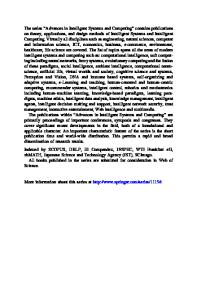Intelligent Processing of Materials for Plasma Deposition
- PDF / 1,250,978 Bytes
- 7 Pages / 420.48 x 639 pts Page_size
- 69 Downloads / 318 Views
Mat. Res. Soc. Symp. Proc. Vol. 190. @1991 Materials Research Society
(a)
(b)
Figure 1. Streamline and isotherm countours of an RF plasma, using detailed Free Stream Model, (a) without, and (b) with particle loading (Fe-20% Mn particles in an argon plasma). Received from D. Wei. Close examination of the results in Figure 1 indicates that the introduction of particles radically affects the plasma temperature only in a narrow core zone adjacent to the centerline. Interactions between the particles and plasma gas only occur inside this central core region, where the particles absorb energy from the plasma and become molten droplets. The dashed line in Figure lb indicates the natural boundary to this core region that exhibits increasing diameter as the distance from the injector increases. It is interesting to note the weak influence of the particles on the flow field. There is almost no significant change in the streamlines due to the particles, possibly because the level of particle loading is too small to have any serious momentum impact in the plasma gas flow. Further information is contained in Figures 2 and 3, which are also results from the detailed Free Stream Model [4]. Figure 2 shows the plasma temperature along the centerline as a function of axial distance, under different particle loading conditions. The effect of the particles on the plas10000 9000 2'A
8000 0
7000
LU
6000
cc
5000
8
4000
9wJ
a-
3000 I-
2000 1000 0.2
0.3
0.4
AXIAL DISTANCE (m)
Figure 2. Plasma temperature along centerline, using detailed Free Stream Model, under different particle loading conditions (Fe-20% Mn particles in an argon plasma). Received from D. Wei.
AXIAL DISTANCE (m)
Figure 3. Plasma velocity along centerline, using detailed Free Stream Model, under different particle loading conditions (Fe-20% Mn particles in an argon plasma). Received from D. wi.e
5
ma temperature is very significant. Figure 3 shows the plasma velocity along the centerline, also as a function of axial distance, under the same particle loading conditions. The effect of the particles on the plasma velocity is secondary. One of the most efficient ways to decouple the phenomena within the gun and plume and speed up the solution procedure was to decouple the system at locations where the spatial derivative of the dependent variable is zero. Otherwise, many iterations are required to assure the flux continuity between the individual domains, as described by the domain decomposition concept [5]. For this problem, the dependent variable is the plasma temperature, and the system can thus be decoupled along the line connecting the zero derivatives of temperature with respect to the radial coordinate; that is, the dashed line in Figure lb. Thus, the system can be broken mathematically into two regions, the central core region and the free stream region. The central core region is assumed to contain all of the particles, and all interactions between plasma and particles are assumed to occur within it. Examination of the streamlines in Figure 1 r
Data Loading...











